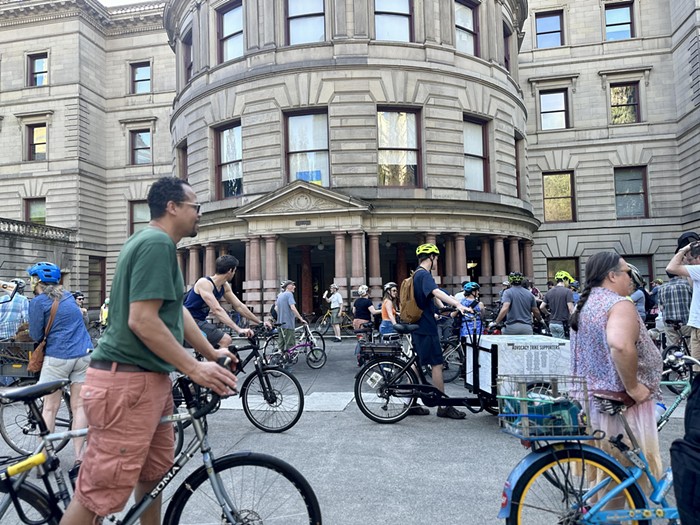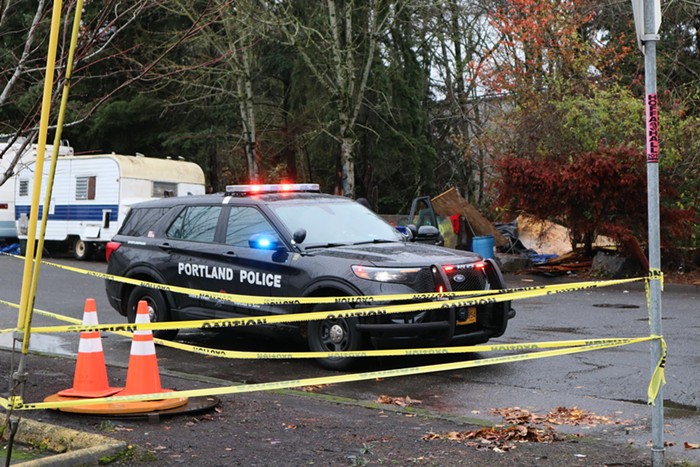
With the Pacific Northwest recording its third heatwave in just over a month, cooling centers in Portland are becoming commonplace.
This week, Multnomah County and the City of Portland coordinated four 24/7 cooling centers throughout the city: Arbor Lodge Shelter in North Portland, Sunrise Center in East Portland, the Portland Building downtown, and Kellogg Middle School in Southeast Portland. The county estimates 780 people have used the cooling centers over the past three days.
Chris Drake sought out a cooling center with his dog Rory after walking into his apartment Wednesday and quickly becoming drenched in sweat.
“I felt like I walked out of a swimming hole,” Drake said.
Originally, the pair went to the Portland Building cooling center downtown, but that center quickly reached capacity. Both the Arbor Lodge and the Sunrise Center cooling centers were also highly trafficked Wednesday and Thursday, prompting the city and county to open a fourth shelter at Kellogg Middle School in SE Portland.
Drake drove to the school Thursday and stayed in the school’s gymnasium where a grid of bedroll mats are laid out across the floor for people to sleep and relax.
Each center has a table full of snacks—like individual bags of chips, applesauce cups, and Cup of Noodles—and pallets upon pallets of bottled water. Multnomah County also orders meals from local restaurants for each center’s guests and volunteers. According to a county spokesperson, just over 2,800 meals were ordered to serve the three original shelters for five days, and the fourth shelter for four days. So far, about 1,400 of those meals have been delivered.

In order to be properly staffed, each center must have at least one lead coordinator and four additional volunteers. Ideally, there are two leads, eight volunteers, one medical staff member, and one behavioral health staff member who is trained in de-escalation, psychological first aid, crisis intervention, or is a licensed behavioral health professional.
Many of the volunteers see their role as making sure things run smoothly so people using the center can fully relax and feel safe spending several days at the shelter, if need be.
“We’re not controlling the space, so much as letting the space be and making sure things are safe,” said Jake Dornblaser, a Portland Bureau of Emergency Management employee volunteering at the Kellogg Middle School center.
Ken Huelsman, a county employee acting as one of the Arbor Lodge Shelter’s lead coordinators, also placed an emphasis on facilitating the safety of the space, but otherwise being hands off.
“It’s important to be meeting people where they are instead of having conditions at the door,” Huelsman said. The only condition enforced at the door is that everyone wears a mask inside the building in compliance with the county and state’s mask mandate. Otherwise, people are free to come and go as they please.
This week, the Arbor Lodge Shelter has typically hosted the most people during the hottest portions of the afternoons and overnight, according to volunteer Mia Edera. If people want to leave during the cooler parts of the day and come back at night, the volunteer staff help save their “dorm”—one of the 64 taped-off sections of the floor with a bedroll.

Erica Scout has been staying at the Arbor Lodge center since it opened Wednesday.
“I’m prone to heatstroke, so I’m here making sure I don’t cook my head off,” Scout said, who doesn’t have access to air conditioning at home. Scout opted to spend her days at the shelter, writing in her journal and socializing with other guests, and plans to leave once the triple-digit heat passes.
The Sunrise Center in East Portland saw 78 guests during its first 24 hours, according to volunteer Caleb Tel Coder. Tel Coder is a member of Cultivating Initiatives, a nonprofit in East Portland that aims to create safer communities by providing services to underserved community members. The organization helped coordinate the Sunrise Center cooling center during the previous heatwaves, and operated the facility as a warming center during February’s ice storm.
The Sunrise Center also offers an outdoor hygiene center where people can take showers and a misting station—a tent with misters hanging from it—outside in the parking lot.
During the historic heat dome in late June, 62 people died from overheating in Multnomah County. Majority of those deaths occurred in East Portland, an area of the city with fewer trees and more heat islands—swaths of concrete that retain heat and make it more difficult for the neighborhood to cool down. While Portland recorded temperatures of up to 116 degrees at the end of June, areas of East Portland reached up to 124 degrees.
On Thursday afternoon when temperatures peaked around 104 degrees, several people walked through the misting tent outside the Sunrise Center to grab a cold water bottle or a damp, cold towel from the chest of ice nearby before moving on.

Following the historic death toll after the heat dome in June, the City of Portland received criticism for not opening more cooling shelters or declaring a state of emergency. The city and county are currently reviewing their coordinated response to the heat dome and detailing what responses did and did not work in an After Action Report. The final report will propose solutions for long term issues—like how to proactively identify households that need cooling resources during extreme heat—as well as offer short term solutions that can be implemented immediately. Some changes, like an increase in heat warnings via public alert systems, have already been put in place during this heatwave.
With record-breaking heat waves seemingly becoming a monthly summertime occurrence in Portland, Huelsman at the Arbor Lodge Shelter hopes that volunteering and continuing to spread the word about cooling centers can help avoid a repeat of the heat dome’s large death toll in Multnomah County. According to the county, there is already one suspected heat-related death since this heatwave started on August 11. There were also at least 10 heat-related hospital visits in the first two days of the heatwave—more than the average single visit per day, but much less than the 150 visits recorded during the heat dome.
“I’d like to think that for most of us, we have that mindset of being civil servants and just want to step up to meet the need,” Huelsman said.
All four cooling shelters are open 24/7 until 9 am Sunday, August 15. Anyone interested in volunteering can visit the county’s website to sign up.



















